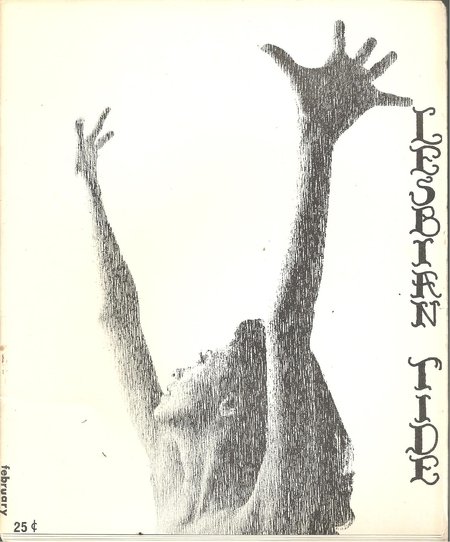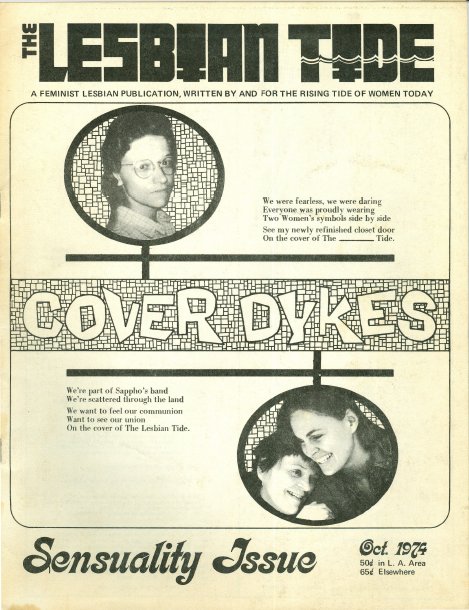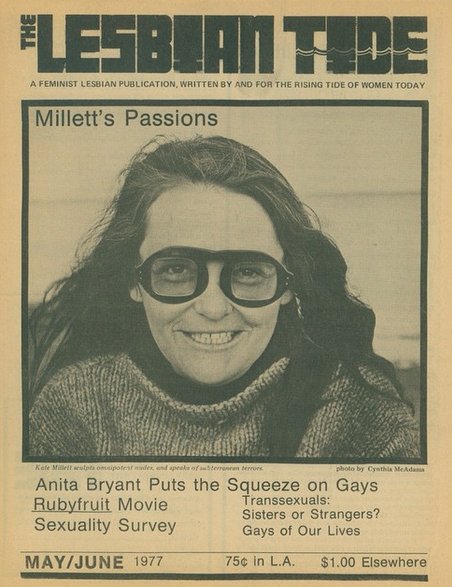There are a couple of principles I keep in mind when studying history. The first is, “You have to work with the evidence you have.” We have no way of knowing how many people secretly had relationships like Arthur Munby and Hannah Cullwick, but left no historical evidence. Likewise, I and other scholars of this particular field have to contend with the lack of historical material about lesbian SM before the 1970s. Maybe somewhere there’s an old journal or manuscript or audiotape sitting in somebody’s basement, and someday somebody will find it and open up a new field of study.
The second principle is, “Absence of evidence is not evidence of absence.” It’s highly unlikely there were no lesbian women doing SM before 1974, but we can only make cautious, educated inferences based on what evidence we do have.
Thankfully, somebody scanned and posted old issues of Lesbian Tide, which contain what may be the earliest mentions of BDSM in lesbian media. As I mentioned before, lesbian SM emerged into visibility at the same time and in dialectic with more restrictive theorizations of lesbian-feminist sexuality, and it cannot be discussed without also discussing this conflict.
Perhaps visible lesbian sadomasochism began in October 1974 (PDF)i, when Lesbian Tide published “The Spirit is Feminist but the flesh is?,” by Karla Jay. In the opening paragraph, Jay claimed, “I’ve seen countless sisters rant against any sort of sexual inequality in a lesbian relationship only to hear later that their favorite sexual ‘sport’ is sado-masochism.”ii Jay’s off-hand mention and the apparent lack of response from readers suggests that lesbian SM was a known practice, if not common or widely accepted. However, “…social pressure has also forced some sado-masochists and lesbians living as prostitutes to live in this second closet.”iii The essay concerns the conflicts between people’s desires and fantasies and their ideologies. “What’s the poor lesbian to do who sincerely believes she should act out or somehow explore her sexual fantasies, only to discover her fantasies center, for example, on sadism, masochism, or some kind of fetishism?”iv
Jay explored the controversy among lesbians over sadomasochism along with other practices like dildo use and prostitution, and asked whether one could or should control one’s sexual fantasies. She favored individuals following their own consciousness, but acknowledged she had no resolution to those conflicts. Lesbian sexuality was a diverse and complex field.vFrom the beginning, lesbian sadomasochism had a complex and difficult relationship with lesbian-feminism.
The next year, Barbara Lipschutz (aka Barbara Ruth, aka Drivenwoman) published “Cathexis (on the nature of S&M)” in Hera, reprinted in Lesbian Tide May-June 1977 (PDF) .vi Lipschutz idealized lesbian sadomasochism, proclaiming it was not only feminist but superior to heterosexual vanilla sex in providing women pleasure, because of women’s supposedly superior relational abilities.vii In her follow up article, “Coming Out on S&M” in 1976, Lipschutz linked SM and lesbianism as personal truths that were difficult to admit in public.viii
In 1976, Lesbian Tide printed a transcript (PDF) of a conscious-raising session in which women discussed sadomasochism in a variety of ways: as body work for expressing emotions (“being restrained has helped me with releasing energy in my pelvic area that has been blocked”), as intense expressions of devotion (“Taking or having complete control, or having another woman give me that much control, total control, to me is one of the most beautiful experiences I’ve ever had.”), as uncertain territory (“Sometimes I wonder how far I would really go, either as a sadist or masochist? What are my limits? What are healthy limits? What are feminist limits? What are human limits?”), or part of a continuum of all sexuality (“Sexuality, any kind of sex, then bondage and dominance, and then sado-masochism is all on a continuum of control. Most sex in this society is based on control, on giving and taking. I think this can be real unhealthy or real wonderful and beautiful….”).ix
Later came Patrick (then known as Pat) Califia’s article “A Secret Side of Lesbian Sexuality”, published in The Advocate in 1979. Califia recalled later:
I was terrified when I wrote it. I kept getting up in the middle of typing to lie down until my nausea subsided and my hands stopped shaking. When that issue of The Advocate hit the newsstands, it was days before I could actually look at my words in print. x
Califia described the lack of organizational infrastructure for S/M lesbians, even in the post-Stonewall years. While lesbian bars had existed for decades, lesbians had not yet developed more specialized sexual subcultures, or at least not to the same degree as gay men.
Lesbian S/M isn’t terribly well-organized yet. […] We don’t have bars. We don’t even have newspapers or magazines with sex ads. I sometimes think the gay subculture must have looked like this when gay life first became urbanized. Since our community depends on word-of-mouth and social networks, we have to work very hard to keep it going. It’s a survival issue.xi
Activist and academic Gayle Rubin described it:
When I came out as a lesbian sadomasochist, there was no place to go. A notice I put up in my local feminist bookstore was torn down. It took months of painstaking detective work to track down other women who were into S/M. There was no public lesbian S/M community to find, so I had to help build one.xii
S/M lesbians had to find allies in gay men and pro-dommes, for education and venues such as the Catacombs fisting club and other gay leather bars that allowed women.
***
iIn 1972, Echo of Sappho published a seven-page interview with Beverly, a member of the recently-founded Eulenspiegel Society. Beverly described herself as lesbian and often co-topped a male submissive with another lesbian. However, she also said she refused to dominate another woman on feminist grounds. Warner 2011, Pg. 54
iiWarner 2011, Pg. 27-29, quoting Karla Jay, “The Spirit is Feminist but the flesh is?” Lesbian Tide, (Oct 1974): p. 1
iiiJay, Karla. 1974. Pg. 15
ivJay, Karla. 1974. Pg. 15
vThat Jay used a paraphrase of Matthew 26:41 in the Christian Bible (“Watch and pray so that you will not fall into temptation. The spirit is willing, but the flesh is weak.”) is almost prophetic, as much of the “lesbian sex wars” paralleled Judeo-Christian themes concerning the body and the soul.
viRobinson 2015 Pg. 65
viiWarner 2011, Pg. 33- 36
viiiWarner 2011, Pg. 37
ixCordova, Jeanne. 1976. “Towards a Feminist Expression of Sado-Masochism”. Lesbian Tide. Nov/Dec 1976. Pg. 14-17
xCalifia, Pat. 1994. Public sex: the culture of radical sex. Pittsburgh, Pa. [u.a.]: Cleiss Press. Pg.12
xiCalifia, 1994. Pg.157
xiiRubin, Gayle, in SAMOIS (Organization). 1987. Coming to power: writings and graphics on lesbian S/M. Boston: Alyson Publications. Pg.222





